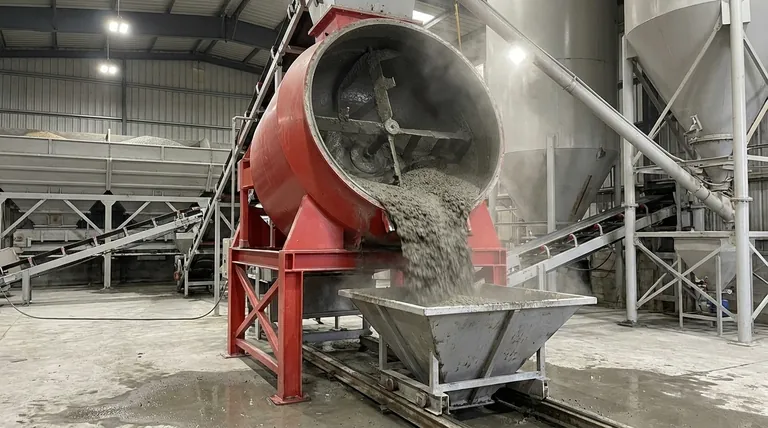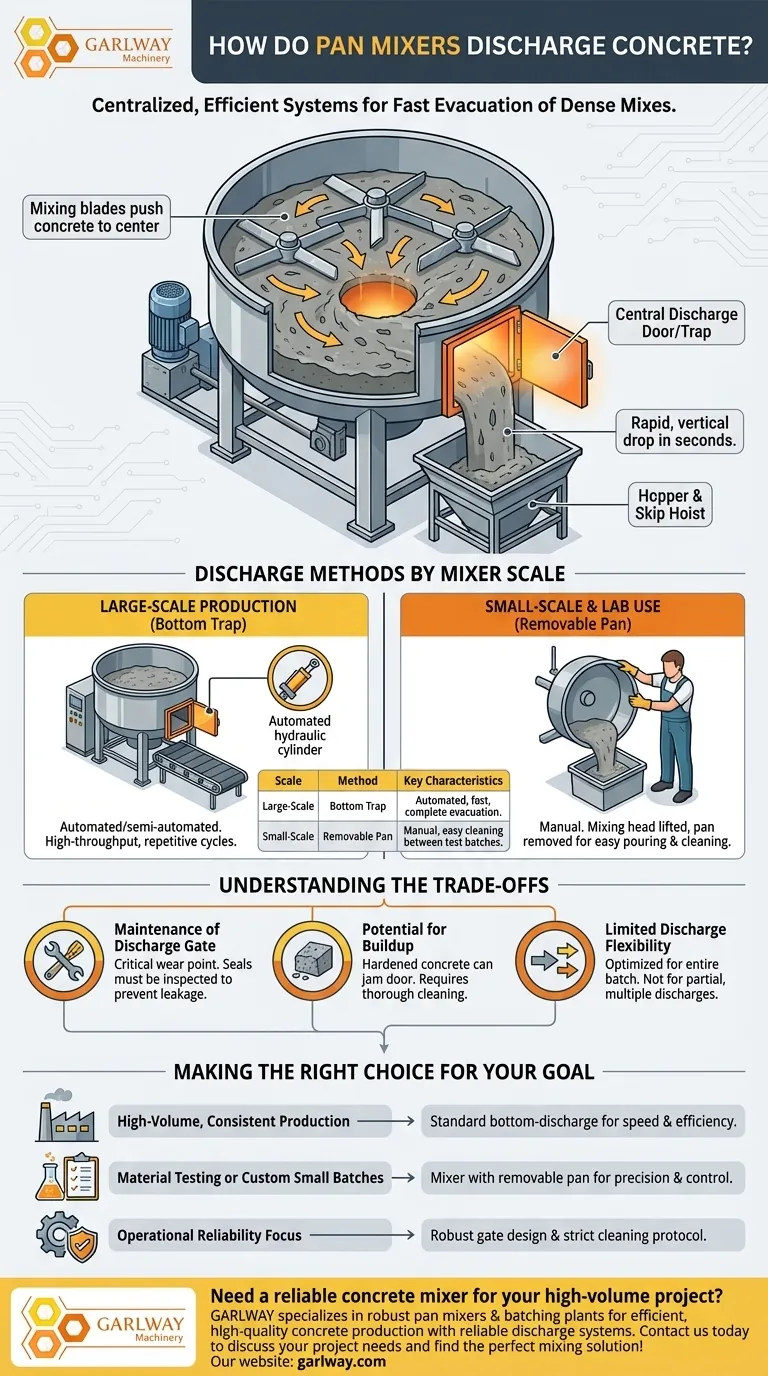Pan mixers discharge concrete almost exclusively through a discharge door, often called a trap, located at the bottom of the stationary pan. This central discharge system is a core design feature. For very small, lab-scale mixers, the process is manual: the mixing blades are lifted out and the entire pan is removed to be emptied.
The bottom discharge mechanism is not just a convenience; it is fundamental to the pan mixer's ability to quickly and completely empty the dense, stiff, and highly homogeneous concrete mixes it is designed to create.

The Mechanics of Bottom Discharge
The operational principle of a pan mixer's discharge is straightforward but highly effective, designed for speed and the nature of the material it handles.
The Central Discharge Door
Most industrial pan mixers have one or more sealed doors integrated into the floor of the pan. When the mixing cycle is complete, this door is actuated—either manually, pneumatically, or hydraulically—to open.
The Role of Mixing Blades
The star-shaped mixing blades and paddles do more than just combine materials. During discharge, their continued rotation pushes the mixed concrete towards the open door, ensuring a fast and complete evacuation of the batch.
Controlled and Rapid Evacuation
This design allows the entire batch of concrete to be dropped vertically in a matter of seconds. It's ideal for feeding a hopper, skip hoist, or concrete bucket waiting directly below the mixer.
Discharge Methods by Mixer Scale
The specific method of discharge is directly related to the size and application of the pan mixer.
Large-Scale Production: The Bottom Trap
For any mixer used in a precast or ready-mix plant, the bottom discharge door is standard. This automated or semi-automated system is essential for the high-throughput, repetitive cycles of a production environment.
Small-Scale & Lab Use: Removable Pan
For mixers with a capacity under roughly 20 liters, a bottom door is impractical. In these cases, the mixing head is lifted or tilted away, and the operator simply lifts the lightweight pan to pour out the contents. This allows for easy and total cleaning between test batches.
Understanding the Trade-offs
While highly efficient, the bottom discharge system has specific operational considerations that are critical for reliable performance.
Maintenance of the Discharge Gate
The seals around the discharge door are a critical wear point. They must be kept clean and regularly inspected to prevent leakage of cement paste during mixing, which can alter the water-cement ratio and lead to performance issues.
Potential for Buildup
Hardened concrete can accumulate around the gate mechanism if not cleaned thoroughly after each shift. This buildup can prevent the door from closing properly, leading to lost material, or prevent it from opening at all, causing costly downtime.
Limited Discharge Flexibility
The bottom-door design is optimized for discharging the entire batch at once. It is not well-suited for partially discharging into multiple smaller containers, such as wheelbarrows, a task better handled by a tilting drum mixer.
Making the Right Choice for Your Goal
Understanding the discharge mechanism helps align the equipment with your operational needs.
- If your primary focus is high-volume, consistent production: The standard bottom-discharge pan mixer provides the speed and efficiency essential for a batching plant.
- If your primary focus is material testing or custom small batches: A mixer with a removable pan offers the necessary precision, control, and ease of cleaning for laboratory work.
- If your primary focus is operational reliability: Ensure you select a mixer with a robustly designed discharge gate and implement a strict cleaning protocol to prevent buildup and seal failure.
Ultimately, the pan mixer's discharge system is purpose-built for its role in producing high-quality, specialized concrete with speed and precision.
Summary Table:
| Mixer Scale | Primary Discharge Method | Key Characteristics |
|---|---|---|
| Large-Scale Production | Bottom Discharge Door (Trap) | Automated/hydraulic; fast, complete batch evacuation for hoppers/skips. |
| Small-Scale & Lab Use | Removable Pan | Manual; entire pan is lifted and poured for easy cleaning between test batches. |
Need a reliable concrete mixer for your high-volume project?
GARLWAY specializes in construction machinery, offering robust pan mixers and concrete batching plants designed for construction companies and contractors globally. Our equipment ensures efficient, high-quality concrete production with reliable discharge systems.
Contact us today to discuss your project needs and find the perfect mixing solution!
Visual Guide

Related Products
- Ready Mixer Machine for Construction Ready Mix Machinery
- Commercial Construction Mixer Machine for Soil Cement Mixing Concrete
- Hydraulic Concrete Mixer Machine Cement Mixing Equipment for Mixture Concrete
- JZC500 Large Cement Mixer Machine Price for Concrete Mix
- Portable Electric Small Cement Mixer Concrete Machine
People Also Ask
- What safety considerations are important for concrete mixer operation? A Guide to Proactive Risk Management
- Which type of projects require a concrete mixer? Essential Guide for Construction Pros
- When was the first concrete mixer developed and by whom? Discover the 1900 Breakthrough
- What was significant about Roscoe Lee's 1934 concrete mixer design? Pioneering Modular Construction Equipment
- What is the average lifespan of a concrete mixer? Maximize Your Equipment's Lifespan & ROI

















